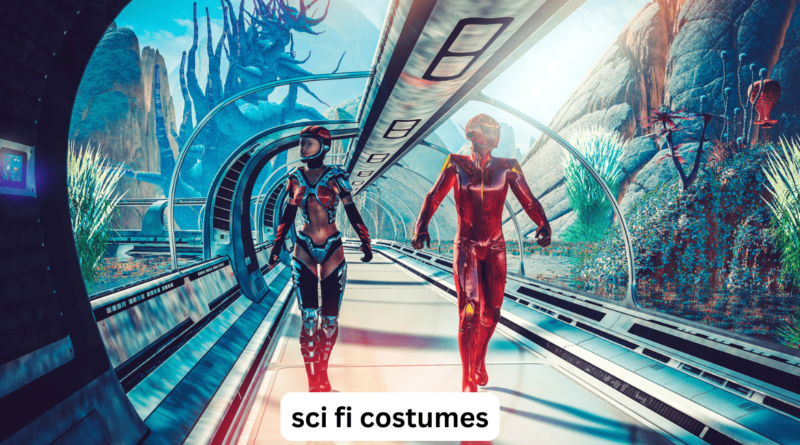Sci Fi Costumes: A Journey Through Time, Space, and Creativity
sci fi costumes have captured the imaginations of fans and creators alike, from the early days of cinema to the latest streaming series. These costumes are more than just clothing; they are symbols of worlds that could be, reflective of the times they were created in, and sometimes even predictive of future fashion trends. Whether you’re attending a comic convention, preparing for Halloween, or simply a sci-fi enthusiast, understanding the history, design, and cultural impact of sci fi costumes is essential.
The Evolution of sci fi costumes
The journey of sci fi costumes began in the early 20th century, with the birth of science fiction as a genre. Early sci-fi films like Metropolis (1927) and Flash Gordon (1936) set the stage for what was to come. The costumes in these films were groundbreaking, designed to reflect futuristic societies and advanced technologies.
As special effects improved, so did the costumes. The 1960s brought us the iconic uniforms of Star Trek, which were simple yet effective in conveying the utopian vision of the future. The 1970s and 1980s saw a boom in sci-fi films, with Star Wars and Blade Runner leading the charge. These films introduced more complex and detailed costumes, blending elements of fantasy, cyberpunk, and post-apocalyptic styles.
In the 21st century, sci fi costumes have become even more sophisticated. With the rise of superhero movies and streaming series, the demand for high-quality, detailed, and realistic costumes has skyrocketed. Shows like The Mandalorian and Stranger Things have pushed the boundaries of what sci fi costumes can be, combining practical effects with cutting-edge technology.
Iconic sci fi costumes Through the Decades

- Metropolis (1927) – The Maschinenmensch: The Maschinenmensch, or “Machine-Person,” is one of the most iconic sci fi costumes of all time. Designed by sculptor Walter Schulze-Mittendorff, this metallic suit was worn by Brigitte Helm in Fritz Lang’s Metropolis. The costume’s design was revolutionary, reflecting the film’s themes of industrialization and the dehumanization of workers.
- Flash Gordon (1936) – Ming the Merciless: The costume of Ming the Merciless, the antagonist of the Flash Gordon serial, set the standard for sci-fi villain attire. With its elaborate headgear, ornate robes, and exaggerated shoulders, Ming’s costume has become a symbol of the genre’s early days.
- Star Trek (1966) – The Starfleet Uniform: The Starfleet uniform is perhaps the most recognizable sci fi costumes in television history. Designed by William Ware Theiss, these uniforms were simple yet effective, using color to denote rank and division within the crew. The uniforms have evolved over the decades but remain a staple of the franchise.
- Star Wars (1977) – Darth Vader: Darth Vader’s costume is arguably the most iconic in sci-fi history. Designed by Ralph McQuarrie and John Mollo, the suit was a combination of samurai armor and a gas mask, creating a menacing and unforgettable look. The black armor, flowing cape, and helmet have become synonymous with the character and the franchise as a whole.
- Blade Runner (1982) – The Replicants: The costumes in Blade Runner were designed by Michael Kaplan and Charles Knode, blending 1940s noir with a dystopian future. The replicants’ costumes, in particular, are a mix of high fashion and utilitarian wear, reflecting their artificial nature and the bleak world they inhabit.
- The Matrix (1999) – Neo: Neo’s costume, designed by Kym Barrett, became a cultural phenomenon. The long black coat, sleek sunglasses, and minimalist design reflected the film’s themes of reality and illusion. The costume has been widely imitated and remains a favorite among fans.
- The Mandalorian (2019) – The Mandalorian Armor: The Mandalorian’s armor, designed by Joseph Porro, is a perfect blend of practicality and style. The beskar steel armor plates, weathered appearance, and helmet with a T-shaped visor create a look that is both futuristic and steeped in tradition. The costume has become an instant classic in the sci-fi genre.
The Design Process: From Concept to Creation
Creating sci fi costumes is a complex and collaborative process that involves concept artists, costume designers, fabricators, and often the actors themselves. The design process typically begins with a concept artist, who creates initial sketches based on the character’s personality, the world they inhabit, and the story being told.
Once the concept is approved, the costume designer works closely with fabricators to bring the design to life. This may involve 3D printing, sculpting, sewing, and sometimes even metalworking. The materials used in sci fi costumes are often a mix of traditional fabrics and modern materials like EVA foam, thermoplastics, and LEDs.
The final step in the process is fitting the costume to the actor. This is a crucial stage, as the costume must not only look good but also allow for movement and comfort. In some cases, adjustments are made on set to accommodate stunts or special effects.
The Cultural Impact of sci fi costumes
sci fi costumes have had a profound impact on popular culture, influencing fashion, art, and even technology. The sleek, futuristic designs of films like The Matrix and Tron have inspired designers in the fashion industry, leading to trends like cyberpunk and techwear.
Cosplay, a hobby where fans create and wear costumes of their favorite characters, has also been heavily influenced by sci fi costumes. Conventions like Comic-Con have become a hub for cosplayers, where elaborate and detailed sci fi costumes are often showcased.
Moreover, sci fi costumes often reflect the hopes and fears of the times they were created in. For example, the dystopian attire in Blade Runner reflects the anxieties of the 1980s, while the utopian uniforms of Star Trek embody the optimism of the 1960s. In this way, sci fi costumes serve as a lens through which we can view our own society and its potential futures.
sci fi costumes in the Digital Age
The advent of digital technology has revolutionized the way sci fi costumes are designed and created. 3D modeling and printing have allowed for more intricate and detailed designs, while CGI can enhance or even replace physical costumes in post-production.
One notable example of this is the Iron Man suit from the Marvel Cinematic Universe. While the suit was initially built as a practical costume, advancements in CGI allowed the filmmakers to create more dynamic and complex versions of the suit in later films.
Virtual reality (VR) and augmented reality (AR) are also beginning to play a role in sci fi costumes design. Designers can now use VR to visualize and tweak costumes in a 3D space before they are even built.
DIY sci fi costumes: Bringing the Future to Life
For those who want to create their own sci fi costumes, the possibilities are endless. Whether you’re a seasoned cosplayer or a beginner, there are a few key tips to keep in mind:
- Research and Inspiration: Start by researching your favorite sci-fi films, shows, or books for inspiration. Look at the details of the costumes, the materials used, and how they reflect the character and world.
- Planning and Sketching: Once you have a clear idea of what you want to create, start sketching out your design. Consider the materials you’ll need, how the costume will be constructed, and any special effects you want to include.
- Material Selection: Choosing the right materials is crucial for a successful sci fi costumes. EVA foam is a popular choice for armor and props, while thermoplastics like Worbla are great for creating detailed pieces. LEDs can add a futuristic touch to your costume, and fabric paint can be used to create unique textures and patterns.
- Construction and Assembly: Building a sci fi costumes can be a time-consuming process, so be patient and take your time. Start with the basic structure, then add details and embellishments as you go. If you’re new to costume-making, consider starting with a simpler design before tackling more complex projects.
- Final Touches: Once your costume is complete, it’s time to add the final touches. This might include weathering, adding special effects, or creating props to accompany your costume. Don’t forget to test your costume for comfort and mobility, especially if you plan to wear it for extended periods.
The Future of sci fi costumes

As technology continues to advance, the future of sci fi costumes looks brighter than ever. The integration of wearable technology, smart fabrics, and AI could lead to costumes that not only look futuristic but also function in ways we can only imagine.
For example, smart fabrics could allow costumes to change color or pattern in response to environmental stimuli, while AI could be used to create costumes that adapt to the wearer’s movements or even enhance their abilities.
In the world of film and television, advancements in CGI and virtual production could lead to even more realistic and immersive sci fi costumes. As the line between the digital and physical worlds continues to blur, the possibilities for sci fi costumes design are virtually limitless.
FAQs about sci fi costumes
- What materials are commonly used in sci fi costumes? sci fi costumes often use a combination of traditional and modern materials. EVA foam, thermoplastics like Worbla, and 3D-printed components are popular for creating armor and props. Fabrics with metallic or reflective finishes are also common, as are LED lights for adding futuristic elements.
- How do I start making my own sci fi costumes? Begin by researching your favorite sci-fi characters and films for inspiration. Sketch out your design, choose the appropriate materials, and plan the construction process. Start with a simple design if you’re a beginner, and gradually work your way up to more complex costumes.
- What are some iconic sci fi costumes I can draw inspiration from? Some iconic sci fi costumes include Darth Vader from Star Wars, the Starfleet uniforms from Star Trek, Neo’s outfit from The Matrix, and the Mandalorian armor from The Mandalorian. These costumes have left a lasting impact on popular culture and continue to inspire new designs.
- How have advancements in technology influenced sci fi costumes? Technology has significantly impacted sci fi costumes design, with 3D modeling, printing, and CGI allowing for more intricate and dynamic costumes. Wearable technology and smart fabrics are also starting to play a role, offering new possibilities for interactive and adaptive costumes.
- Can sci fi costumes predict future fashion trends? Yes, sci fi costumes often reflect societal trends and can influence future fashion. The cyberpunk aesthetic seen in films like Blade Runner and The Matrix has inspired fashion trends like techwear, while the sleek designs of futuristic uniforms may influence the look of real-world workwear.
Conclusion
sci fi costumes are more than just clothing; they are a gateway to other worlds, a reflection of our hopes and fears, and a testament to human creativity. From the metallic suits of Metropolis to the high-tech armor of The Mandalorian, these costumes have shaped the way we imagine the future. Whether you’re a designer, cosplayer, or simply a fan, the world of sci fi costumes offers endless possibilities for exploration and inspiration.
As we look to the future, the integration of new technologies and materials will continue to push the boundaries of what sci fi costumes can be. Whether you’re creating a DIY costume or admiring the latest designs on screen, the journey through the world of sci fi costumes is one of endless discovery and wonder.

